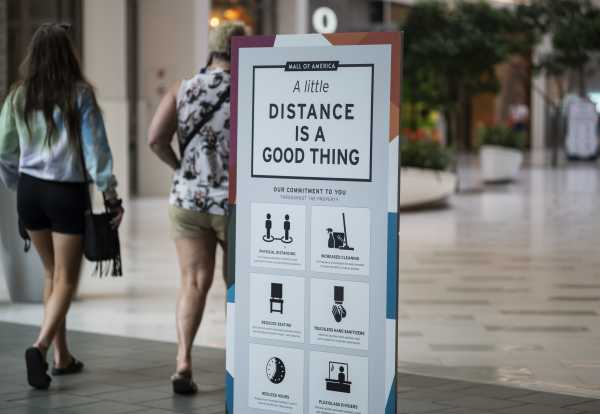
Part of
The Vox guide to navigating the coronavirus crisis
The United States may be seeing the beginning of a new wave of Covid-19 cases: Fourteen states and Puerto Rico have hit new seven-day average highs of new coronavirus infections, the Washington Post reports, Some of that may be due to increased testing (the more testing that’s done, the more cases are found). But Arizona, in particular, is on high alert: ICU beds are filling up, and the state’s health director has told hospitals to start activating their emergency plans.
At the Atlantic, Robinson Meyer and Alexis Madrigal argue it looks like the United States is already “giving up” on public health measures. The White House coronavirus task force is barely meeting anymore. People are crowding together again in indoor casinos.
Also: The mass protests against police brutality and for racial justice could spread the virus further. (Many protesters know the risks and have thoughtful reasons for participating anyway.) Police have acted as though a pandemic isn’t happening: forcing crowds into confined spaces, tear-gassing them, and jailing protesters in cramped cells.
Related
8 states that experts worry are the new Covid-19 hot spots
It’s much too soon to give up. The dangerousness of this virus, of this pandemic, hasn’t changed. No matter what happens in the news over the next weeks and months, this will still be true.
“The situation is not fundamentally all that different from six months ago,” Sarah Cobey, an infectious disease modeler at the University of Chicago, says. “We still have a highly transmissible virus, and the vast majority of the population remains susceptible to it. The situation is arguably even worse now since the virus is so much more widespread than it was a few months ago.” Plus, now, as states relax social distancing policies, more people risk being exposed (unless they take the well-established precautions).
Here’s what everyone needs to know about why the pandemic isn’t going away, and why we can’t give up fighting it.
1) “Opening up” the economy exposes more people to the coronavirus
Back in February, public health experts were worried about outbreaks igniting from travelers abroad returning to the United States. Now those sparks are everywhere in the United States.
If the coronavirus is a wildfire, then we humans are the trees, the fuel. In March and April, when most of the country was under some form of stay-at-home or lockdown order, most of us trees (except essential workers) were spread far apart from one another.
Now that states are allowing people to put themselves in closer proximity to others, the fire can more easily jump from person to person.
2) We’re nowhere near the threshold for herd immunity. Most people can still get infected.
For the pandemic to simmer down naturally — in a way that will allow life to go back to normal — the population needs to achieve something called herd immunity. For the coronavirus, herd immunity could possibly be achieved when 50 percent of the population is immune. But it could be as high as 65 percent.
But no area is anywhere near that figure, even New York City, where at least 17,000 people have died of Covid-19. In late April, it was estimated that 20 percent of the city had been exposed to the coronavirus.
Related
6 feet away isn’t enough. Covid-19 risk involves other dimensions, too.
Elsewhere, the infection rates are much, much lower. “There’s no evidence that there’s some big accumulation of immunity in the population,” Natalie Dean, a biostatistician at the University of Florida, says, especially places that have avoided a big Covid-19 wave so far. There’s plenty more fuel for this fire.
Herd immunity cannot be achieved without a massive amount of pain and death. Fifty percent of the United States infected means 160 million infections. One in 200 of those could result in death. That’s 800,000 deaths. We’ve already seen an enormity of pain and death, but even greater pain and death are possible.
In May, a team of Harvard scientists modeled how long it would take to achieve herd immunity in the US if the country was cautious and avoided overwhelming the hospital system. “Prolonged or intermittent social distancing may be necessary into 2022,” they concluded.
3) We don’t have to choose between endless lockdowns and mass deaths. There are other ways to manage the pandemic.
Herd immunity is not the only way for the pandemic to end. We can manage the spread and contain it to small clusters with an aggressive system of testing and tracing the contacts of the infected.
This work is made difficult by the fact that people can spread the virus before they know they are sick. This virus is sneaky. “We have so many infections that are undetected,” Dean says. That will make it hard to contain.
Related
Asymptomatic coronavirus spread is real
But that challenge can be addressed. “We’ve seen clear examples of how transmission appears to be controllable with widespread testing and physical distancing, including mask-wearing,” Cobey says. Look at South Korea, for example. “If most people on the planet could take those precautions, perhaps the virus would go away.”
In the absence of test-and-trace deployments, we can all do our best to try to reduce our chances of spreading the coronavirus to others: by wearing masks, by maintaining distancing between people, by avoiding crowds indoors, among other suggestions to reduce harm while rejoining society in a limited capacity.
Related
8 ways to go out and stay safe during the coronavirus pandemic
4) This virus could lull us into a false sense of security
It takes an average of five days for a person to show symptoms after being infected with Covid-19, but it can take up to 14. And after infection, it takes time to get tested and time for the results to come back.
Some people won’t get tested, and their cases will only be noted when they arrive at a hospital. A person can be contagious a day or two before they start feeling symptoms (or never develop symptoms at all), and may remain contagious until several days after symptoms end.
This all means that by the time new cases start to appear in the data, a new wave of infections is already well underway. Let’s not get complacent. The increase in cases in some communities now is the result of changes that began several weeks ago.
5) A vaccine can end the pandemic. But not immediately.
There is not yet a vaccine to prevent SARS-CoV-2 from infecting people. Even if there is eventually a vaccine to inoculate people against the coronavirus, the pandemic won’t immediately end. It may not be perfectly effective, and there may not be enough of it.
Let’s not lose sight of how it will take an enormous effort to end the pandemic. Humans have only eradicated two diseases via vaccine — smallpox and a cattle disease called rinderpest — and in both cases, it was the result of enormous global efforts. Don’t imagine eradicating this virus will be any easier.
We’re in for a long haul, unfortunately. But that doesn’t mean we should give up.
These new infections aren’t a surprise. Epidemiologists warned us that reopening too quickly could backfire. When we let up on precautions without putting new ones in place — like a national test, trace, and isolation effort and universal masking — the virus will find lots of new people to infect. The models told us this too: The places most at risk for a second wave are the places that largely avoided the first one (like Arizona), and didn’t prepare well for a second. These places have populations that are almost entirely susceptible to infection. Removing the most powerful thing protecting them — social distancing — without new precautions in place just leaves them exposed.
The pandemic is still just beginning. Sigh if you need to. Screaming helps too (just not in an enclosed space with other people around). But we can’t give up now.
Support Vox’s explanatory journalism
Every day at Vox, we aim to answer your most important questions and provide you, and our audience around the world, with information that has the power to save lives. Our mission has never been more vital than it is in this moment: to empower you through understanding. Vox’s work is reaching more people than ever, but our distinctive brand of explanatory journalism takes resources — particularly during a pandemic and an economic downturn. Your financial contribution will not constitute a donation, but it will enable our staff to continue to offer free articles, videos, and podcasts at the quality and volume that this moment requires. Please consider making a contribution to Vox today.
Sourse: vox.com






